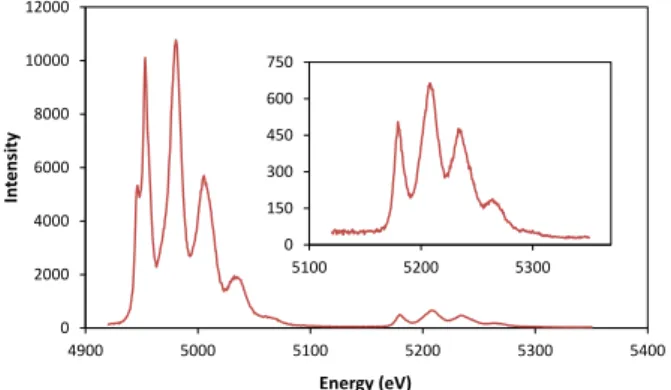High energy resolution measurements of the radiative decay of double
K-shell vacancies in 20
≤ Z ≤ 29 elements bombarded by fast C and Ne ions
J.-Cl. Dousse* 1, Y.-P. Maillard*, M. Berset*, D. Castella*, J. Hoszowska*, M. Kavčič†, M.Kobal†, O. Mauron*, A. Muehleisen†, P.-A. Raboud*, J. Rzadkiewicz‡, K. Tökési£ and B. Zorko†
*Department of Physics, University of Fribourg, CH-1700 Fribourg, Switzerland † J. Stefan Institute, SI-1001 Ljubljana, Slovenia
‡National Centre for Nuclear Research, 05-400 Otwock, Swierk, Poland
£ Institute of Nuclear Research of the Academy of Sciences (ATOMKI), H-4001 Debrecen, Hungary
Synopsis. We report on high energy resolution measurements of the Kα hypersatellite x-ray spectra of Ca, V, Fe
and Cu induced by impact with 144 MeV C and 180 MeV Ne ions.
The double inner-shell ionization induced by
photon and electron impact is rather weak. In con-trast to that, x-ray satellites and hypersatellites with markedly higher intensities are observed in x-ray spectra resulting from collisions of atoms with heavy ions. Due to the strong Coulomb field of the projec-tile, several inner-shell electrons of the target atom can be indeed ionized simultaneously. As a conse-quence, x-ray spectra induced by heavy ion impact exhibit usually rich satellite and hypersatellite struc-tures. High-resolution measurements of heavy-ion induced K-hypersatellites were found to be a sensi-tive tool for investigating the relativistic and quan-tum electrodynamics (QED) effects in atoms [1] and the dynamics of multiple ionization of atoms by heavy-ion impact [2].
In the present experiment the K-shell double ionization of Ca, V, Fe and Cu induced by impact with 12 MeV/amu C4+ ions and 9 MeV/amu Ne6+ ions was investigated. The measurements were per-formed at the Paul Scherrer Institute (PSI) in Villi-gen, Switzerland. The ions produced by a 10-GHz CAPRICE ECR source were accelerated to the final energies by the variable energy Philips cyclotron of PSI. The x-ray spectra were measured by means of high resolution x-ray spectroscopy, using the von Hamos curved crystal spectrometer of Fribourg [3]. The intensity of the beam which was in the range of 100–200 nA was monitored by observing the sam-ple K x-ray fluorescence by means of a Si PIN pho-todiode. The fluorescence x-rays from the target were collimated by a 0.2 mm tantalum slit defining the effective source width. The Ca and V spectra were collected using a LiF (200) crystal, whereas for Fe and Cu a SiO2 (2-23) crystal was employed.
The diffracted x-rays were measured with a two-dimensional position-sensitive deep depleted CCD detector.
For illustration, the x-ray spectrum correspond-ing to the Ne-V collision is depicted in figure 1. As shown, L-satellites up to the 4th order were ob-served for the diagram and hypersatellite transi-tions.
From the fits of the high-resolution x-ray spectra, the centroid energies, linewidths and relative intensi-ties of the transitions of interest were extracted and compared to theoretical predictions. A particular aim of this project was to determine the double K-shell photoionization cross sections for the investigated collisions. The cross sections were derived from the hypersatellite-to-diagram intensity ratios and com-pared to theoretical calculations performed within the SCA and CTMC models.
0 2000 4000 6000 8000 10000 12000 4900 5000 5100 5200 5300 5400 In ten si ty Energy (eV) 0 150 300 450 600 750 5100 5200 5300
Figure 1. High-resolution K x-ray spectrum of V
in-duced by impact with 180 MeV Ne ions. The first group of lines correspond to the KαLn diagram and
L-satellite transitions, the second one to the KαhLn
hypersatellite transitions.
References
[1] M.H. Chen et al 1982 Phys. Rev. A 25 391 [2] D.K. Olsen et al 1974 Phys. Rev. Lett. 33 194 [3] J. Hoszowska et al 1996 Nucl. Instrum. Phys.
Res. A 376 1
1
E-mail: jean-claude.dousse@unifr.ch
XXIX International Conference on Photonic, Electronic, and Atomic Collisions (ICPEAC2015) IOP Publishing Journal of Physics: Conference Series 635 (2015) 022054 doi:10.1088/1742-6596/635/2/022054
Content from this work may be used under the terms of theCreative Commons Attribution 3.0 licence. Any further distribution of this work must maintain attribution to the author(s) and the title of the work, journal citation and DOI.
